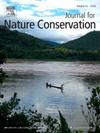Taxonomic and conservation implications of the rediscovery of Racemobambos ceramica (Poaceae, Bambusoideae), an endemic bamboo of Seram Island, Indonesia, after a century
IF 2.5
3区 环境科学与生态学
Q2 BIODIVERSITY CONSERVATION
引用次数: 0
Abstract
Racemobambos ceramica S.Dransf. (Poaceae, Bambusoideae), an endemic bamboo species from Seram Island, Indonesia, was first described in 1980. The description was based on a single specimen (Rutten 2234) collected in 1919 from Makina, deposited at Herbarium Bogoriense (BO). The protologue lacked details on the shoot, culm and culm leaf morphology. A 2024 rediscovery of R. ceramica at Manusela National Park, Seram Island, has expanded its known distribution beyond the original locality, marking its rediscovery after 105 years. This rediscovery offers a chance to refine the morphological description and evaluate its conservation status. It also provides data to predict habitat suitability and then forecast the distribution of R. ceramica on Seram Island. This study aimed to revise the taxonomic description of R. ceramica, assess its conservation status, and identify potential habitats across Seram Island. Research was conducted through field surveys on Seram Island and the analysis of herbarium specimens. Based on these findings, we provided a more detailed morphological description of R. ceramica. A preliminary assessment classifies R. ceramica as Near Threatened (NT) on the IUCN Red List of Threatened Species. The habitat of R. ceramica is best suited to karst hill and mountain complexes, thriving on sloped terrain above 1000 m in forested areas. Our model predicts that R. ceramica habitat suitability is highest in the Manusela National Park highlands, especially around Mount Binaiya, spanning Seram Utara to northwestern Telutih, and in western (Taniwel and Taniwel Timur) and southern (Tehoru) Seram.
印度尼西亚Seram岛特有竹种Racemobambos ceramica (Poaceae, Bambusoideae)在一个世纪后重新发现的分类和保护意义
赛姆奥巴马陶瓷有限公司。竹科(Poaceae, Bambusoideae)是印度尼西亚Seram岛的特有竹种,于1980年首次被发现。该描述基于1919年在马基纳收集的单一标本(Rutten 2234),存放在波哥大植物标本馆(BO)。在茎部、茎和茎叶的形态上缺乏详细的描述。2024年,在Seram岛的Manusela国家公园,人们重新发现了R. ceramica,将其已知的分布范围扩大到了原来的位置之外,标志着它在105年后被重新发现。这一发现为完善其形态描述和评估其保存状况提供了机会。研究结果还可为预测黄麻的生境适宜性,进而预测黄麻的分布提供依据。本研究的目的是为了修正色兰岛的陶瓷砂属植物的分类描述,评估其保护状况,并确定其潜在的栖息地。研究是通过在Seram岛进行实地调查和分析植物标本馆标本进行的。在此基础上,我们对陶土进行了较为详细的形态描述。经初步评估,陶瓷花属世界自然保护联盟濒危物种红色名录近危物种。陶砂最适合喀斯特丘陵和山地复合体的生境,生长在森林地区1000 m以上的斜坡地带。我们的模型预测,在Manusela国家公园高地,特别是在Binaiya山附近,横跨Seram Utara至telutith西北部,以及Seram西部(Taniwel和Taniwel Timur)和南部(Tehoru), ceramica的生境适宜性最高。
本文章由计算机程序翻译,如有差异,请以英文原文为准。
求助全文
约1分钟内获得全文
求助全文
来源期刊

Journal for Nature Conservation
环境科学-生态学
CiteScore
3.70
自引率
5.00%
发文量
151
审稿时长
7.9 weeks
期刊介绍:
The Journal for Nature Conservation addresses concepts, methods and techniques for nature conservation. This international and interdisciplinary journal encourages collaboration between scientists and practitioners, including the integration of biodiversity issues with social and economic concepts. Therefore, conceptual, technical and methodological papers, as well as reviews, research papers, and short communications are welcomed from a wide range of disciplines, including theoretical ecology, landscape ecology, restoration ecology, ecological modelling, and others, provided that there is a clear connection and immediate relevance to nature conservation.
Manuscripts without any immediate conservation context, such as inventories, distribution modelling, genetic studies, animal behaviour, plant physiology, will not be considered for this journal; though such data may be useful for conservationists and managers in the future, this is outside of the current scope of the journal.
 求助内容:
求助内容: 应助结果提醒方式:
应助结果提醒方式:


